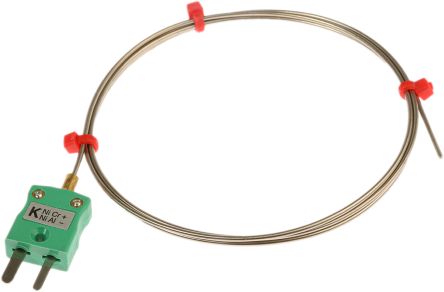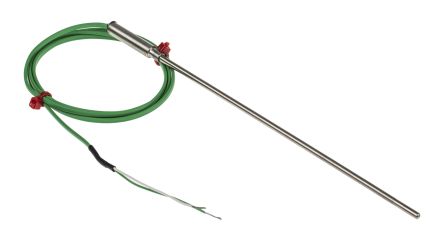- Published 5 Sept 2025
- Last Modified 5 Sept 2025
- 9 min
Introduction to Industrial Temperature Measurement
This guide dives deep into industrial temperature measurement equipment. It explores different types of sensors, factors to consider when choosing them, and best practices for efficient temperature monitoring.

Reviewed by Peter Kendall (Technical Support Engineer), May 2024
Accurate and reliable temperature measurement is crucial in various industries. From ensuring product quality in manufacturing to maintaining safe working environments, monitoring temperature plays a vital role in optimising processes and minimising downtime.
What are Temperature Sensors?
Temperature sensors convert temperature variations into electrical signals. This signal can then be displayed on a readout, recorded for data analysis, or used to control other equipment. They come in various shapes and sizes, catering to diverse industrial applications.
Types of Temperature Measurement
There are two ways to measure temperature, each with its own advantages and limitations:
- Contact Measurement: This method involves direct physical contact between the sensor and the object whose temperature needs to be measured. Common examples include thermocouples, Resistance Temperature Detectors (RTDs), and thermistors
- Non-Contact Measurement: This method uses infrared radiation to measure temperature without touching the object. This is particularly useful for moving objects or surfaces that are difficult to reach
How to Measure Air Temperature?
For measuring air temperature, various options are available. Room temperature checkers, often used in domestic settings, are basic thermometers that provide a quick and easy reading. For more sophisticated applications, data loggers can be used to record temperature readings over time, allowing for detailed analysis of temperature fluctuations.
Exploring Temperature Measurement Devices
Temperature probes and sensors are the workhorses of industrial temperature measurement. They are often interchangeable, though probes typically house the sensor and provide a physical interface for measuring the temperature of a particular medium. Common types include:
- Thermocouples: These robust sensors offer a wide temperature range and fast response times, making them suitable for harsh environments and dynamic processes
- RTDs: RTDs are known for their high accuracy and stability, particularly in lower temperature ranges. They are commonly used in applications requiring precise temperature control
- Thermistors: These are semiconductor-based sensors that exhibit significant resistance changes with temperature variations. They provide fast response times but have a limited temperature range
Industrial Thermometers
Industrial thermometers are specialised instruments designed for specific industrial applications. They can be digital or analogue, offering features such as data logging, alarms, and remote monitoring capabilities.
Thermal Testers
Thermal testers are used for more specific applications, such as testing materials’ thermal conductivity or evaluating heat sink performance. They often involve controlled heating or cooling elements and sophisticated temperature measurement capabilities.

Selecting the Right Temperature Sensors
Choosing the right temperature sensor for your application is crucial for efficient and reliable temperature monitoring. Here are some key factors to consider:
- Temperature Range: Select a sensor that can accurately measure the entire range of temperatures you expect to encounter
- Accuracy: Consider the accuracy level required for your process. Higher accuracy sensors may be necessary for critical applications
- Response Time: How quickly does the sensor need to respond to temperature changes? This is particularly relevant for processes with rapid temperature fluctuations
- Environment: The sensor needs to be compatible with the surrounding environment, considering factors like pressure, vibration, and exposure to chemicals
Comparison of Different Types of Temperature Sensors
In industrial settings, selecting the right temperature sensor is crucial for accurate and reliable temperature measurement.
Here's a more in-depth comparison of three common types of temperature sensors, highlighting their strengths and weaknesses to guide your selection process:
Thermocouples
- Temperature Range: Thermocouples boast the widest operating range of the three sensor types, typically spanning from -260°C to +2300°C. This versatility makes them suitable for extreme temperature applications, common in industries like metal processing, glass manufacturing, and high-temperature furnaces
- Advantages:
- Ruggedness: Thermocouples are known for their durability and ability to withstand harsh environments. They can endure high pressures, vibrations, and chemicals exposure, making them ideal for demanding industrial applications
- Fast Response Time: Thermocouples offer fast response times, meaning they can detect temperature changes rapidly. This is beneficial for monitoring processes with quick fluctuations, such as temperature quenching or welding
- Cost-effective: Compared to other sensor types, thermocouples are generally less expensive, making them an attractive option for applications where cost is a major consideration
- Disadvantages:
- Lower Accuracy at Lower Temperatures: While boasting a wide range, thermocouple accuracy can be less precise at very low temperatures. For applications demanding high accuracy across a broader spectrum, other sensor types might be more suitable
- Requires Reference Junction: Thermocouples require a reference junction, which is a point maintained at a constant temperature. Any variations in the reference temperature can affect the overall measurement accuracy
- Specialised Measurement Techniques: Using thermocouples effectively often requires specific connection methods and data acquisition equipment to convert the voltage output of the sensor into a readable temperature value
Resistance Temperature Detectors (RTDs)
- Temperature Range: RTDs typically operate within a moderate range, from around -200°C to +850°C. This range caters to various industrial processes, but it might not be suitable for extremely high or low temperatures
- Advantages:
- High Accuracy: RTDs are renowned for their exceptional accuracy, particularly in lower temperature ranges. This makes them ideal for applications where precise temperature control is critical, such as pharmaceutical manufacturing or sensitive chemical reactions
- Good Stability: RTDs exhibit excellent long-term stability, meaning their calibration remains reliable over extended periods. This reduces the frequency of recalibration needed compared to other sensor types
- Linear Output: RTD electrical resistance changes linearly with temperature across its operating range. This simplifies the conversion of the sensor's output into a temperature reading
- Disadvantages:
- Slower Response Time: Compared to thermocouples, RTDs generally have slower response times. This may not be ideal for processes requiring very rapid temperature monitoring
- More Expensive: RTDs tend to be more costly than thermocouples. This is a factor to consider when cost is a significant constraint.
- Susceptibility to Physical Damage: While generally robust, the thin element used in some RTDs can be more susceptible to physical damage than the sturdier construction of thermocouples
Thermistors
- Temperature Range: Thermistors have a limited temperature range, typically from -50°C to +150°C. This restricted range confines their use to applications where temperature monitoring falls within these boundaries
- Advantages:
- Very Fast Response Time: Thermistors offer the fastest response time among the three sensor types. This makes them well-suited to highly dynamic processes or situations where minute temperature changes need to be captured quickly
- High Sensitivity: Thermistors exhibit a significant change in resistance with even small temperature variations. This high sensitivity allows for very precise detection of subtle temperature fluctuations
- Relatively Low Cost: Thermistors are generally the most affordable option among these three sensor types
- Disadvantages:
- Low Accuracy: Thermistors generally have lower accuracy than RTDs and may not be suitable for applications demanding extremely precise temperature control
- Limited Temperature Range: Thermistors’ restricted operating range limits their use in many industrial applications
- Non-Linear Output: The relationship between resistance and temperature in thermistors is non-linear. This necessitates complex conversion circuitry to translate the sensor's output into a readable temperature value
Importance of Temperature Monitoring in Industrial Settings
Temperature monitoring plays a critical role in various industrial settings:
- Maintaining Product Quality: In industries like food and beverage production, pharmaceuticals, and chemical processing, precise temperature control is essential for consistent product quality. Deviations from optimal temperatures can lead to product spoilage, altered properties, or even safety hazards
- Ensuring Safety: Extreme temperatures can pose safety risks in various industrial environments. Monitoring temperatures prevents overheated equipment, which could lead to fires or explosions. Additionally, in processes involving hazardous materials, temperature control is crucial for preventing accidents and safeguarding personnel
- Regulatory Compliance: Many industries are subject to regulations that mandate specific temperature control measures. Temperature monitoring systems aid in adherence to these regulations, ensuring compliance and avoiding potential fines or production shutdowns
Tips for Effective Temperature Monitoring
Here are some key practices for effective temperature monitoring:
- Define Monitoring Points: Identify critical points within your process where temperature control is crucial. This will determine the placement of sensors for optimal data collection
- Select Appropriate Sensors: Choose sensors with the appropriate temperature range, accuracy, and response time based on your specific application
- Utilise Data Logging Systems: Implement data logging systems to record temperature readings over time. This allows for trend analysis, anomaly identification, and proactive maintenance scheduling
- Set Alarms and Alerts: Configure alarms and alerts to notify operators of any deviations from desired temperature ranges. This enables prompt corrective action before issues escalate
- Train Personnel: Ensure personnel responsible for monitoring temperatures understand the importance of the data and how to respond to any deviations
Summary: Key Points for Efficient Temperature Equipment
Choosing the right temperature measurement equipment and implementing effective monitoring practices are essential for optimising industrial processes. Here are some key takeaways for efficient temperature equipment:
- Select sensors based on the specific requirements of your application: Consider factors like temperature range, accuracy, response time, and environmental compatibility. There's no "one-size-fits-all" solution, so understanding your process needs is crucial
- Implement data logging and analysis: Leverage data logging systems to record temperature readings over time. This allows you to identify trends, predict potential issues, and optimise your processes for improved efficiency and quality control
- Establish regular calibration routines: Schedule regular calibration of your temperature sensors to ensure their accuracy remains within acceptable limits. This is particularly true for critical processes where precise temperature control is essential
- Prioritise preventative maintenance: Develop a preventative maintenance plan for your temperature measurement equipment. This may involve cleaning sensors, inspecting for damage, and following manufacturer recommendations for upkeep
- Train your personnel: Ensure personnel responsible for monitoring temperatures understand the importance of the data and how to respond to deviations. Regular training can help them identify potential issues and take corrective actions promptly
- Invest in quality equipment: While initial cost is a consideration, opting for reliable and well-regarded temperature measurement equipment can save you money in the long run. Durable sensors with lower maintenance requirements and longer calibration intervals can translate into significant cost savings over time
By following these key points, you can ensure your temperature measurement equipment operates efficiently. This will provide you with the reliable data you need to optimise your industrial processes and achieve peak performance.






